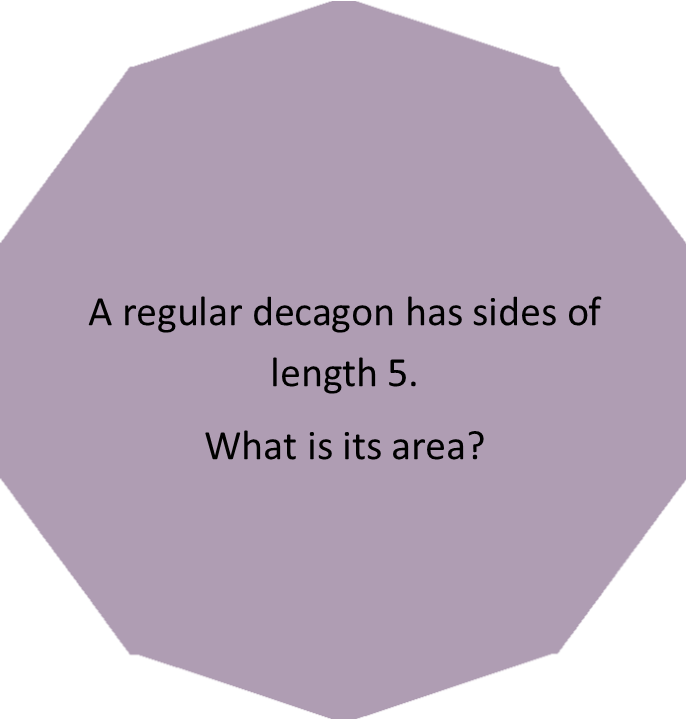Math Made Easy: Problem of the Day 36
On a mathematics group, I saw a post requesting how to determine the area of a regular decagon when you have been given only the length of its sides. So letís do that for todayís problem.

There are two ways to do this. Letís do it the long way first, then Iíll show you the super short way. The long way helps to understand where the short way comes from.
First, letís recognize that I can break up the polygon into numerous right triangles, like so. I see that I have two different sized right triangles, 10 of each. The sides of the decagon make the hypotenuse of the smaller triangles.

Since they are all right triangles, if I can calculate their sides, I can calculate their areas. If I can do that, I can sum their areas to find the area of the decagon. Since I only have one side, and I need to know the other sides of the blue triangles, I need to figure out their angles. Well, itís convenient that the height of the blue triangles bisects the interior angles of the polygon. That means the measure of the blue triangleís angle right there is exactly half that of the measure of the decagonís interior angles. And thereís a simple formula to calculate the measure of a decagonís interior angles. I normally advocate for working in radians, but sometimes, with polygons of high-numbered sides, degrees is actually easier. Iíll work in degrees in this problem, because itís one of those cases.

Now that I know the measure of that angle (half 144, or 72 degrees), I can calculate the height of that blue triangle. I recognize the height is the adjacent side, so using SOHCAHTOA, I remember Cosine Adjacent Hypotenuse, so I can calculate the height using b=c(cos(θ)).

Now I use the Pythagorean Theorem basic formula to calculate the base of the blue triangles.

Now that I have those, I use the general formula for the area of a triangle, recognizing that right triangles are a special case where θ = 90, and the sine of that is just 1.

Moving on to the green triangles. The base of the green triangles is clearly the hypotenuse of the blue ones. And I see that that outer angle on them results from subtracting the small angle of the blue triangles from the interior angle of the polygons twice, and then dividing that by two (since they bisect the resulting angle).

Again using SOHCAHTOA, I can calculate the hypotenuse of the green triangles, only this time dividing that base by the cosine of the angle, since Iím going the other way.

Using the Pythagorean Theorem basic formula again, I calculate the height of the green triangles.

Now I calculate the area of a green triangle the same way I did the blue.

Finally, I sum all the areas. I can clearly see there are 10 blue triangles and 10 green, so I just multiply the area of one of each by 10, then add together:

Our result is correct. If you canít remember the quick way to find the area of a polygon given whatever information you have, breaking it into triangles will work every single time. Itís longer, but you actually donít have to remember as much, because you can just apply your knowledge of triangles to the problem, freeing your brain from having to remember all the different ways to quickly calculate the area of a regular polygon (and there are quite a few, depending on what information youíre given).
I said thereís a faster way, if you can remember the polygon formulae, and there is. For the information we were given, just the side lengths, thereís a quick formula involving ONLY the side lengths and number of sides. It looks like this:

Note it achieved exactly the same result in far fewer steps. So its advantage is its speed. Its disadvantage, is requiring you to remember at least 3 different formulae for the area of a polygon (one for sides given, one for radius (distance from the center of the polygon to a corner), and one for Apothem (distance from center of the polygon to the center of a side).
|



